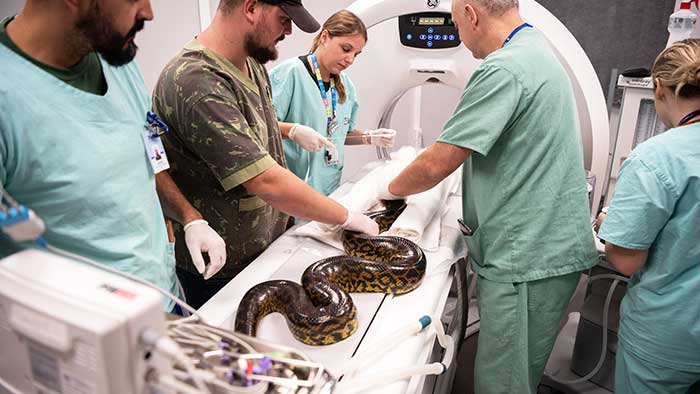On the morning of Tuesday, March 12, a computerized tomography of an anaconda snake mobilized the team of professionals from the Veterinary Hospital Institute (IHVET) at the University of Caxias do Sul.
The animal, approximately two meters long and almost eight kilos, was brought by a team from the Brazilian Institute of the Environment and Renewable Natural Resources (Ibama) in Porto Alegre, where it is under the care of the Wild Animal Screening Center (Cetas). The examination is part of a recognition study of the Yellow Sucuri species whose objective is to consolidate it as an animal of the native fauna of Rio Grande do Sul.
The examination involved a team of veterinarians, nurses and assistants for around an hour and a half. As soon as it arrived at IHVET, the snake was taken to a heated environment, where it remained for a few minutes. “Increasing body temperature is essential for the anesthetics needed for the exam to take effect”, explains veterinarian and professor at the University of Caxias do Sul Claudia Giordani, who performed the tomography. Then, the animal was anesthetized and placed on the tomography table.
The computerized images were recorded in three stages, each one requiring the repositioning of the reptile – and attentive dedication from the team. After an hour the procedure was completed, and after another two hours the snake was awake and active. In mid-afternoon, the anaconda was “discharged” and sent to Cetas. The test results will be ready within four working days, but preliminary everything indicates that she will return to the wild next week, in the same place where she was rescued – read the text below.
The tomography carried out at IHVET is part of a battery of tests that the snake is undergoing, most of them carried out at Cetas itself, where biological and genetic material has already been collected and the epidemiological part has been completed. IHVET was chosen by Ibama to carry out the exam because it is a teaching hospital of a Community University and due to its structure, team and proximity to Porto Alegre. “UCS is our partner, and kindly made itself available to carry out this exam. A very important partnership, which allows us to have high-quality analysis, technology, to provide information on this animal and future species”, observes Wagner.






